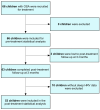Alterations in Gut Microbiota Composition Are Associated with Changes in Emotional Distress in Children with Obstructive Sleep Apnea
- PMID: 39770828
- PMCID: PMC11677172
- DOI: 10.3390/microorganisms12122626
Alterations in Gut Microbiota Composition Are Associated with Changes in Emotional Distress in Children with Obstructive Sleep Apnea
Abstract
Emerging evidence underscores the pivotal role of the gut microbiota in regulating emotional and behavioral responses via the microbiota-gut-brain axis. This study explores associations between pediatric obstructive sleep apnea (OSA), emotional distress (ED), and gut microbiome alterations before and after OSA treatment. Sixty-six children diagnosed with OSA via polysomnography participated, undergoing adenotonsillectomy alongside routine educational sessions. ED was assessed using the OSA-18 questionnaire, categorizing participants into high ED (scores ≥ 11, 52%) and low ED (scores < 11, 48%) groups. Gut microbiome analysis revealed significant diversity differences, with high ED linked to a reduced Shannon index (p = 0.03) and increased beta diversity (p = 0.01). Three months post-treatment, significant improvements were observed in OSA symptoms, ED scores, and gut microbiome alpha diversity metrics among 55 participants (all p < 0.04). Moreover, changes in the relative abundances of Veillonella, Bifidobacterium, Flavonifractor, and Agathobacter, as well as ultra-low frequency power and low frequency power of sleep heart rate variability, were independently associated with ED score alterations. These findings underscore the gut microbiome's critical role in the emotional and behavioral symptoms associated with pediatric OSA, suggesting that microbiome-targeted interventions could complement traditional treatments for ED reduction and emphasizing the need for further research.
Keywords: adenotonsillectomy; children; dietary profile; educational counseling; emotional distress; gut microbiome; obstructive sleep apnea; sleep heart rate.
Conflict of interest statement
The authors declare no conflicts of interest.
Figures






Similar articles
-
Alterations of Gut Microbiome Composition and Function Pre- and Post-Adenotonsillectomy in Children with Obstructive Sleep Apnea.J Otolaryngol Head Neck Surg. 2024 Jan-Dec;53:19160216241293070. doi: 10.1177/19160216241293070. J Otolaryngol Head Neck Surg. 2024. PMID: 39544149 Free PMC article.
-
Dietary profile of pediatric obstructive sleep apnea patients, effects of routine educational counseling, and predictors for outcomes.Front Public Health. 2023 Jun 12;11:1160647. doi: 10.3389/fpubh.2023.1160647. eCollection 2023. Front Public Health. 2023. PMID: 37377550 Free PMC article.
-
Characteristics of salivary microbiota in children with obstructive sleep apnea: A prospective study with polysomnography.Front Cell Infect Microbiol. 2022 Aug 29;12:945284. doi: 10.3389/fcimb.2022.945284. eCollection 2022. Front Cell Infect Microbiol. 2022. PMID: 36105146 Free PMC article.
-
The role of the microbiota-gut-brain axis and artificial intelligence in cognitive health of pediatric obstructive sleep apnea: A narrative review.Medicine (Baltimore). 2024 Dec 13;103(50):e40900. doi: 10.1097/MD.0000000000040900. Medicine (Baltimore). 2024. PMID: 39686454 Free PMC article. Review.
-
Exploring the potential relationships among obstructive sleep apnea, erectile dysfunction, and gut microbiota: a narrative review.Sex Med Rev. 2023 Dec 23;12(1):76-86. doi: 10.1093/sxmrev/qead026. Sex Med Rev. 2023. PMID: 37385976 Review.
References
Grants and funding
LinkOut - more resources
Full Text Sources

